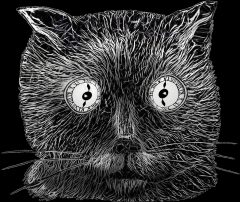Law-Abiding Images: The Basics of Digital Image Copyright
Hopefully you are aware that not every image on the Internet is free for you to use on your website. If not, consider this your heads-up that digital copyright laws are real and serious. You are responsible for making sure that you have the appropriate permissions to use images on your website.
Luckily, we’ve put together some resources for finding images that you can safely and legally use. Those can be found here: The Ultimate Guide to Finding Images for your Website.
This post, however, is a crash course on the basics of digital copyright, so you can confidently use, attribute, edit, and distribute images without breaking the law. If you’re in a rush to put up your images, though, you can skip straight to a summary of this post – you’ll miss some detail (including two adorable cat pictures), but you’ll be presented with the essentials.
Image Usage Rights
Images have different rules and restrictions attached to their usage. Some of the most common ones that you’ll be interacting with as a web content manager are detailed below.
Public Domain

Public domain images are images that were either never copyrighted or whose copyright expired. This means that they can safely be used, modified, and distributed without needing permission or even attribution. You may need to consider moral and privacy rights in certain cases, however.
The image to the right is an edited version of a book illustration from 1880. The copyright on the original book illustration is likely expired, allowing the creator of this image to modify the original and post their work. It has been tagged as public domain as neither the original illustration nor the artist who modified it are claiming copyright over it.
Creative Commons
Creative Commons is a non-profit organization dedicated to providing images for common use. They provided licenses for image creators to use in order to specify the rights they want to maintain over their work. Two of the most commonly used licenses are described here, with an explanation of additional conditions below. For more detail on other types of licensing and exact specifications, consult Creative Commons themselves!
CC0
A Creative Commons Zero (CC0) license is essentially a license that puts the work into the public domain. The same permissions and restrictions apply: that is that you can use, modify, and distribute CC0 images without asking permission or attributing the image.
CC BY 
A Creative Commons Attribution (CC BY) license is similar to that of the CC0 but does require attribution. Attribution means that credit is given to the image creator, that a link to the license is shared, and that it is indicated whether or not changes have been made to the creator’s work.
Attributions can be formatted in many ways, but the best practice is to include the title, creator, and license. The title text should link to the work, while the creator text should link to the profile of the creator, and the license text should link to the Creative Commons page that details the license.
For example, an appropriate attribution for the photo on the right would be “cat” by vincent.chen / CC BY 2.0.
The number that follows “CC BY” specifies which version of the Creative Commons Attribution license the image is under. Though there are differences between each version, all may be used with attribution.
Additional Conditions (NC, SA, ND)
The CC BY license occasionally includes additional conditions, such as non-commercial, share-alike, and/or no derivative works. Creative Commons licenses may include one (ex. CC BY-ND) or multiple (ex. CC BY-NC-SA) of these conditions. The table below briefly summarizes what each of these conditions mean.
| Name | Abbreviation | Explanation |
| Non-Commercial | NC | The work may only be used for non-commercial purposes. The difference between commercial and non-commercial image use is elaborated on below. |
| Share-Alike | SA | Any derivative works (i.e. works that modify and/or use this image) must be shared under the same license as the original work. |
| No Derivative Works | ND | No derivative works (i.e. works that modify and/or use this image) may be created |
Royalty-Free
Royalty-free images are usually found on stock photo sites. What “royalty-free” means is that you don’t need to pay a fee (or, “royalty”) every time you use the photo. For example, Web Services recently purchased a Shutterstock subscription which allowed us to obtain images for our use. Through the agreement Shutterstock has with the images’ copyright holders, we do not need to pay the creators royalties every time we use their photos, since we paid a fee to Shutterstock. Royalty-free images, like the one below, do not require attribution.

Use of Images
Some licenses allow only for certain types of image use. But what is the difference between commercial and non-commercial use? What counts as editorial use?
Commercial or Non-Commercial
The line between commercial and non-commercial usage can be difficult to draw in certain cases. To keep it simple, commercial usage is any usage whose primary function is to make money. This includes images used for marketing, sold on products, or otherwise involved in any money-making.
Conversely, non-commercial image use is any use that is not intended for money-making purposes.
Editorial
Editorial usage is a specific type on non-commercial usage that encompasses images of note-worthy events, people, or places. These cannot be used commercially because permission to display the subjects of the image has not been obtained. For example, a photograph of a famous person may specify editorial use only, meaning that you could use it in an explanation of who this person is, but not to promote a product.
The short answer to “what is editorial use?” is that it is any use that is documentary in nature. You are allowed to use certain images to explain, educate, and document the events or people depicted, but not for any other (commercial or non-commercial) uses.
The Long and Short Arms of the Law: To Sum Up
Copyright law is fairly complex, so here are the main take-aways:
- Images with Public Domain or Creative Commons Zero (CC0) licensing can be freely used – no fees or attribution needed.
- Images with Creative Commons Attribution (CC-BY) can be used with attribution.
- Some CC-BY images also specify Non-Commercial (NC), Share-Alike (SA), or No Derivate Works (ND). These mean that there are extra rules to the use of this image.
- Royalty-free images require a one-time fee to purchase a license to but can thereafter be used without needing to pay for each usage.
- Commercial use of an image is any use that is intended to make money.
If anything, the main idea to remember from this post is that you are responsible for making sure the images used on your website are obeying copyright laws. Don’t break the law just for that cute cat picture! We can help you find copyright-free images easily.
Further Reading
The following articles were referenced in the creation of this post: